| Illustrations from U.S. Money vs Corporation Currency, Alfred Owen Crozier, 1912 |
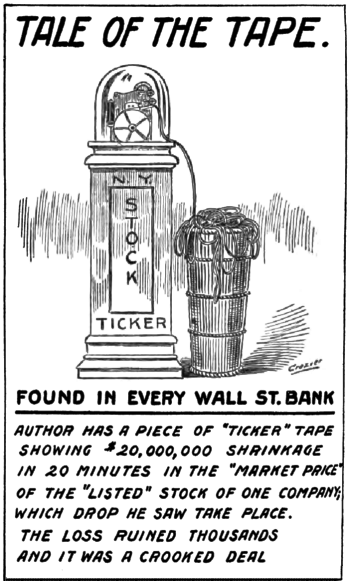
|
|
The Money SwindleSimon Sheppard gives a radical account of modern financePublished in Heritage and Destiny, July-August 2012 |
Few people understand our financial system, because its basic processes are rarely discussed. Even economics graduates have never heard much of this.
Money is not a good, it is a measure. Since the introduction of paper money however, this distinction has been progressively eroded. Originally coinage, made of gold and silver, was issued by both the Crown and church authorities. The first paper money was written receipts for gold.
When the word usury is used nowadays, which is not often, it usually denotes ‘excessive interest.’ But its original and primary meaning was ‘any interest at all.’ Making money from money was illegal under church law. The Third Lateran Council denounced usury as a sin in 1179, and claiming otherwise was declared a heresy in 1312. The taboo continued for several centuries. If a fisherman needed money for a boat, he entered into a profit-sharing arrangement with a business partner; if a house was bought, a “rent” could be paid until the purchase price was reached. Compare that to today, with “interest-only mortgages” where householders pay nothing but interest and never actually own their house.
Carrying gold was burdensome and risky, so the practice arose of depositing it with people, often jewellers, who had strong-boxes. Receipts were issued and these were exchanged, becoming the forerunner of the modern banknote. The Bank of England was established in 1694 to become Britain’s central bank but even its “promissory notes” were still handwritten for the first few years. Gold was carried in the form of sovereign and half-sovereign coins until quite recently. A sovereign was worth twenty silver shillings, or £1, but gold was hastily withdrawn from circulation in August 1914 with the outbreak of World War I.
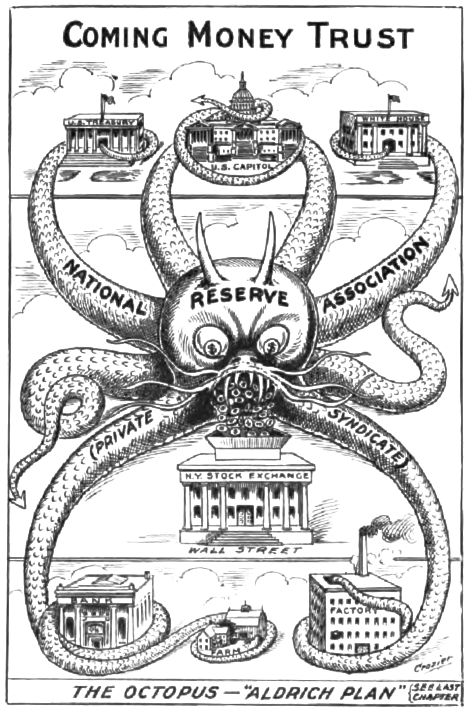
Swindle 1: Fiat currency
The link between money and gold continued until the early thirties, when many countries gave up the “gold standard.” The Bank of England abandoned the last vestiges of it in 1931. Up to that date the bank had been legally obliged to exchange any banknote for its equivalent in gold.
The principle behind the gold standard was that it prevented the runaway printing of money. It was not the only option however. Germany in the inter-war years had almost no gold reserves, and adopted a policy of printing money according to the amount of wealth produced by its workforce. It has been suggested that the resurgence of Germany’s economy was the real provocation for the Second World War. Germany had bucked the stranglehold of debt to international financiers and thrived. The country simply could not be allowed to set an example to other nations.
With the departure from the gold standard the modern era of money began. Without the backing of a tangible asset our money became what is known as a fiat currency, from the Latin fiat, meaning decree. Money’s value is set solely by fiat; in other words, what the government says it is. Ultimately the currency is made legitimate by the fact that the government accepts these notes in payment for debts, i.e. taxes.
The principle of fiat currency bears comparison with a Ponzi scheme, one of the most basic types of financial fraud, named after its Italian originator. In such an arrangement, investments are attracted with the promise of high interest, but the interest payments are really paid by new recruits to the scheme. The original investment – the principal – is squandered to finance the lavish lifestyle of the fraudster, or squirreled away in offshore accounts. Eventually investors will ask for their money back or the fraudster will run out of new suckers to invest in his scheme.
When a government running an economy based on fiat currency gets into trouble, as it surely must, it has two options. Either it can confess its incompetence, and face recriminations for the mess; or alternatively it can print more money and carry on as before. This only delays the inevitable denouement. “I have discovered the secret of the philosopher’s stone, it is to make gold out of paper” wrote John Law, who ruined the French economy by this manner in 1720. This is likely to be repeated.

Consider the situation with government-issued bonds, called gilts. Physically they are just certificates with an ornate surround. Regarded as high grade investments, they are backed by governments, who rarely default on their debts. A government may raise money by printing these certificates and selling them to another, wealthier country, promising to repay that money after a period, typically five years, plus interest, typically five percent. The term of the debt conveniently places the repayment obligation on the shoulders of the following government.
Should a British gilt issue be undersold, that is, not enough buyers have taken up the gilt issue, it is underwritten by the Bank of England, which will print money to purchase the gilts on the same terms. This ensures that all the capital required by the government is raised. Although the Bank of England was nationalised in 1948 it remains independent, and thus can print money, lend it to the government and charge interest on it. Its equivalent in the United States is the Federal Reserve, which despite its name is a private company, and which operates under similar terms.
Thus the sale of gilts has two outcomes: either the taxes paid by British people are used to pay the interest on a loan from wealthy foreigners, making them even richer, or they pay interest to the Bank of England, who only had to print the money to lend it to the government.
‘Quantitative easing’ is just a fancy term for the instant creation of money. Money is generated out of thin air by the Bank of England to inject liquidity – ready cash – into the system. Thus in a fiat currency system the central bank can create money as a debt, and that money, which is merely an entry in a ledger or an addition to a spreadsheet, ceases to exist once the debt is repaid.
Hence we can conceive how using a fiat currency, which allows the unlimited creation of money, can lead to a system of perpetual debt. Similarly, a loan from a high street bank is not real money, it is money that has been contrived solely for the purpose of arranging debt.
Swindle 2: Fractional reserve banking
What’s the difference between a counterfeiter and a banker? Answer: The banker charges interest.
We now move down from the level of ‘fairy-tale money’ created by central banks, to the invention of more virtual money by local banks. Banks attract deposits from customers: the “chump change” of current accounts and larger sums in deposit accounts. These accumulated deposits are lent out to other customers. However, most loans made by the bank are with money which does not exist.
The fractional reserve system is standard banking practice and typically operates with a ratio of ten percent (though recently often less). That is, a tenth of all deposits are held back by the bank as the ‘fractional reserve’: the other nine-tenths are lent out.
This is why a “run on the bank” is such a disaster. True, some of the bank’s reserves will be in medium or long-term investments which are not quickly realisable, but the pressing problem for the bank is that it simply does not have the money. The fundamental assumption of fractional reserve banking – which again, is a completely normal feature of modern banking – is that all the bank’s customers will not ask for their money back at the same time. If they do, disaster befalls it. The cash held at the bank is only that which it expects to issue during the normal course of business.
Suppose £100 is deposited at a bank. Soon, £90 of it will be lent out, but that £90 is bound to return, even before the loan is repaid. The £90 will be used to purchase goods or services, and these payments eventually become deposits at banks. Of that £90 in deposits, £81 will again be lent out. Already £171 has been lent from that initial deposit of £100.
I ran a simple computer simulation to calculate what happens after ten iterations of this 10:90 rule. These iterations will take place – unless money is borrowed from a bank solely to be hoarded under a mattress, an absurd notion. The fractional reserve held by the various banks is £65, but the loans originating from that £100 deposit total £586.
We can appreciate that if a run on a single bank is a calamity, then a run on the banks is catastrophic. The money is not there: it has already been lent out, many times over. Applying the fractional reserve system and by scheduling loans and the repayments on those loans – plus interest of course – even local banks are able to generate money out of nothing.
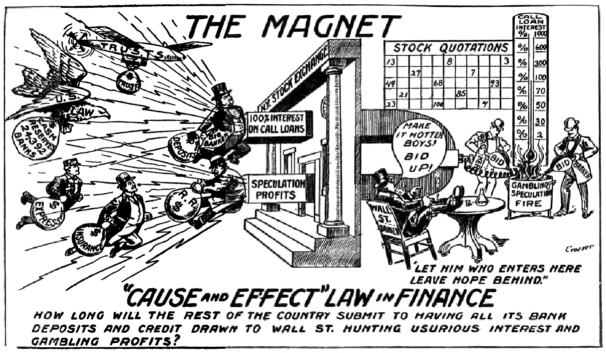
Swindle 3: Churn and burn
When a company grows to a certain size it may decide to become “public”: shares, that is portions of the company, are sold, and this is the class of investment called equities. Shares are traded on stock markets, which according to theory are a perfect economic system where prices are settled according to supply (the number of shares issued) and demand (the attractiveness of the shares). Theoretically the opposing dynamic of fear and greed – fear of loss and the desire to maximize gain – in the psyche of the brokers makes them act as rational dealers acting individually and collectively to establish a perfect equilibrium. That is, the system automatically corrects itself, and share prices accurately reflect their true value.
The fallacy of this was demonstrated with the collapse in summer 2007, when the markets fell over 40%. For months commentators had warned of the danger of the complex mortgage debt bundles (repackaged bad US mortgages) which had been traded worldwide. There were clear signs of problems ahead. Yet brokers collectively dismissed these prophets of looming disaster as “Frasers,” after the Dad’s Army character whose catchphrase was “We’re all doomed!” For three months or so the Stock Exchange was in a state of denial. It was certainly not acting as a perfect economic system.
The original stock market was Dutch, but many theories of stock market dynamics derive from the railway companies which spread across North America during its early development. The railways were a good indicator of financial health since they carried materials for building and the products of that industrial expansion.
Shares are subjected to all manner of manipulation for profit. Four well known gambits are ‘Pump and Dump,’ ‘Short and Distort,’ ‘Poop and Scoop’ and ‘Churn and Burn.’ This last, however, summarises the entire system.
When an investor contacts his broker, he may give instructions to sell or buy a particular stock. Or an investment manager might manage a portfolio of stocks and trade them at his discretion. For every transaction, the broker earns a fee. Whether the investor gains or loses, the broker always profits. He has an incentive to trade, because the more he deals the more he earns. In Churn and Burn, a broker excessively trades (churns) an investor’s stocks to maximize his fees (burning the investor). This has grown on a huge, market-wide scale in recent years.
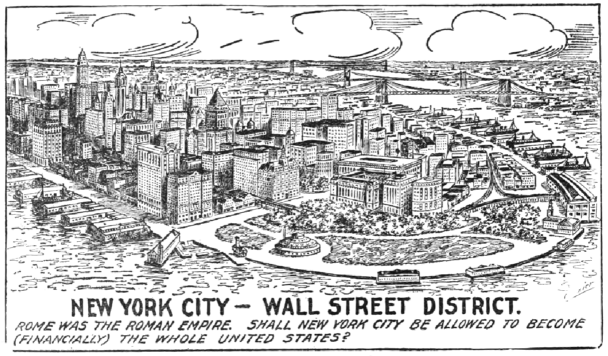
Equities are traditionally medium to long-term investments. For example, an individual might hold a portfolio of stocks for a couple of decades then sell them off slowly to pay for his retirement. However the rate of trading has risen dramatically. Automatic trading is done using computers (‘black box trading’) by which stocks, commodities or currencies might be held for just a few seconds. It is estimated that a barrel of oil now changes hands eighty times before it reaches the end-user.
The result is a system that churns round and round generating commissions on abstract contracts and sliced packages of debt (‘derivatives’) which have little relevance to reality. Even the implosion of many of these financial phasmata in 2007 failed to reduce the turnover: if we define churn-rate as the percentage of shares sold in a year, for the London Stock Market it was 30 percent in 2007, 50 percent in 2008 and 90 percent in 2009. The stock market in its entirety has become a Churn and Burn scam, creaming off wealth solely for the benefit of financial manipulators within the system.
So many shares circulate in pension funds and the like that it is often not necessary for an insider to actually buy shares, only borrow them from a colleague. Shorting is betting on a falling stock price. The stock may fall of its own accord or be distorted, or there may be insider knowledge. A number of shares are borrowed, then sold at the existing price. When the price has fallen, shares are purchased to repay the loan. The difference between the sell price and the cost to repay the borrowed shares is pure profit. Shorting is one practice of many that benefit no-one except the successful trader. No goods are produced and no real wealth is created by these trades. All the benefit is for the manipulators themselves.
Speculating using borrowed money is called leveraging, and leverage ratios have reached unprecedented levels, up to 35 being reported. That is, trades are made using 35-fold the actual capital available. Trading ‘at the margin’ is another method of greatly increasing the size of a nominal stake.
The stock market’s inherent instability allows it to respond to changing conditions. With ever more convoluted “financial products” – borrowing real world terminology, even though nothing is produced – the markets have become dangerously unstable. It is a vast, parasitic drain on society and the people who genuinely create wealth, the bedrock of that society. Created to facilitate capital flow for business, the stock market now threatens to bring the real economy down with it.
The most basic form of leveraged investment is a mortgage: the value of the property is expected to rise, and a loan is taken out to secure that investment. This is of secondary importance to ordinary people however, because a basic human requirement is having somewhere to live.

Swindle 4: Death and taxes
A well-known aphorism is that two things in life are certain: death and taxes. When death and tax are combined in Inheritance Tax the result is a potent mix of iniquity.
A telling example occurred during the Second World War. Sir Josiah Stamp was a director of the Bank of England from 1928 to 1941 and a wealthy man. Sir Stamp lived with his son, who was his heir, in a London suburb. One night in 1941 the property took an unlucky direct hit by a German bomb, and both father and son were killed, probably at the same instant.
Under the laws of Inheritance Tax as applies in such a case, the father was deemed to have died before his son, incurring death duties as the elder Stamp’s estate passed to his son. Then death duties were applied again as the legacy passed from the son to the remaining heirs. That is, the duties were applied twice from a single fatal event.
The plain fact is that Inheritance Tax is levied on wealth upon which tax has already been paid. The case of Sir Stamp is an extreme example, but it vividly illustrates the fundamental injustice of death duties, because this double taxation is actually routine. Income Tax – which was introduced at the time of the Napoleonic Wars as a “temporary measure” – is paid as wealth is accrued, and that wealth is taxed again at death.
In effect, Britain has experienced a Marxist revolution in slow motion. We have endured the progressive centralisation of government, with thousands of new laws encroaching on almost every aspect of our lives, and an oppressive regime of political correctness. The effect has been to mould the population into a conformist and malleable bloc whose main function is to toil for the benefit of a super-rich elite, an elite whose only skill is in manipulating money.
Every society will have an aristocracy of some form, but the effect of Inheritance Tax has been to supplant one aristocracy with another. The number of “Richistanis,” the class of super-rich whose individual wealth is £50million or more, has mushroomed in recent years, increasing an estimated hundred-fold. On the other hand, Britain’s traditional aristocracy have been under sustained attack through the imposition of death duties on their estates.
Britain’s aristocracy have historically been the holders of much of our agricultural land and maintain stately homes up and down the country. They are the guardians of much of our heritage and culture. Family seats which have stood for centuries are being dismantled with each generation due to Inheritance Tax. It is a Marxist process, although executed at a grossly decelerated rate.
The British aristocracy performed another important social role. Having little or no affiliation to a political party, and not being dependent on votes or patronage, they were free to speak frankly on topics which might not otherwise be broached. This is the advantage of a hereditary House of Lords.
Again, Sir Josiah Stamp provides us with a vivid example, though the reliability of the following quote has been questioned. Speaking at the commencement address of the University of Texas in 1927 he is purported to have said:*
‘The modern banking system manufactures money out of nothing. The process is perhaps the most astounding piece of sleight of hand that was ever invented. Bankers own the Earth. Take it away from them, but leave them the power to create money, and with the flick of the pen they will create enough money to buy it back again... Take this great power away from them and all great fortunes like mine will disappear, and they ought to disappear, for then this would be a better and happier world to live in. But if you want to continue to be slaves of the banks, and pay the cost of your own slavery, then let bankers continue to create money and control credit.’
Incidentally, Winston Churchill continued a very old tradition when he specified that his legacy only pass to his male heirs. The abandonment of this practice, with women living typically six to eight years longer than men, has also had a profound effect on society.
Britain’s traditional aristocracy were models of decorum and their affairs and muted scandals were the grist of latter-day newspaper gossip columns. Today’s aristocracy however consists firstly of the afore-mentioned Richistanis, who generally only socialize with each other, tending to avoid publicity in fear of exciting justifiable resentment. Then secondly, for public consumption, grossly overpaid actors, musicians and sportsmen. These and non-entity “celebrities” compete with each other for notoriety by their bad behaviour. It should be obvious which of the traditional or modern type of aristocracy is preferable as a source of role models.
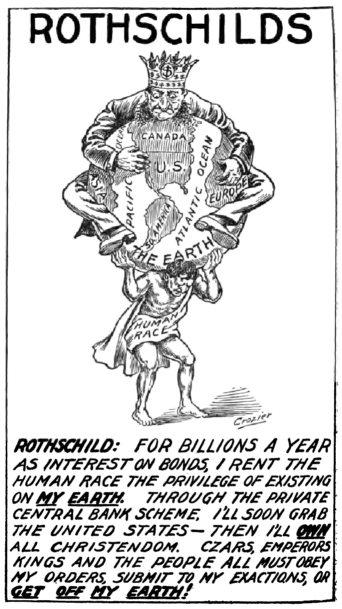
Approaching the end-game
Supporters of the present financial system argue that it has brought us economic growth and prosperity. But at the top of the chain are international capitalists of spurious loyalties with a vested interest in the system that made them super-rich. Their only creed is self-interest. Some are actively dangerous, with George Soros as a good example. A Hungarian Jew, he was educated in England and now lives in America. In 1992 he borrowed £6.5billion to convert to Deutschmarks and French Francs and the loans, in Sterling, were repaid after the pound had lost value. This shorting of Sterling caused ‘Black Wednesday’ and made Soros his first billion. That wealth is now used to finance hundreds of front organisations which cynically orchestrate protest movements around the world.
Under the twin evils of fiat money and usury, large numbers, perhaps all but the super-rich, will be condemned to a life of debt slavery. The truth about how much this has progressed is demonstrated by the increasing difficulty people have buying a home. It shows how much poorer we have become, although our fall in wealth has been hidden by the plummeting cost of consumer gagdets like mobile phones and flat-screen TVs. In 1965, a perfectly ordinary working man could buy a house with a mortgage lasting ten years. His wife had no need to work. Now however, it takes the combined earnings of both man and wife to pay off a mortgage lasting 25 or 30 years. Our wealth is false wealth: the vast sums the Establishment is now squandering on imposing its political dogma, maintaining its hugely bloated bureaucracy, and fighting foreign wars, is the income from tax to be levied on wages our grandchildren have yet to earn.
As confidence in the existing financial order falls, demand for gold rises. Normally gold is stable in the long term, being regarded as a safe haven rather than a profitable investment. Yet its price has increased more than five-fold in the last decade. This is a harbinger of things to come.
Constantly increasing economic growth, like unlimited population growth, is an impossibility. This is especially true for an island of relatively small land area such as Britain. We need to redefine what we mean by wealth, and reaffirm the traditional British attitude that money isn’t everything. Wealth includes having our families close by; living in a community of people whom we understand and who understand us; having enough to eat, and enough space to feel free. To be able to prosper by our own efforts. Concepts of wealth and of nationhood which neglect these factors are base.
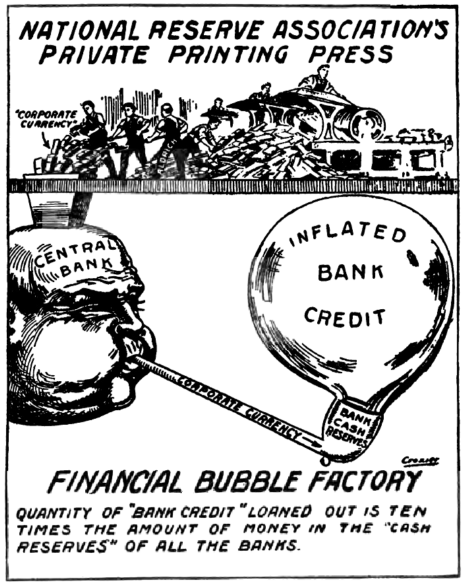
Hurry up and go bust
Just like a casino, the only real winners in our current financial system are the individuals who run it. Those who print money are rich beyond compare, and politicians, with all their perks, are paupers by comparison. The higher up the money chain, the greater is the swindle, and the separation now between those who create wealth by honest toil, practical invention and science, and those who merely cream off fees and percentages by trading in virtual money, is wider than it has ever been. This is an inevitable consequence of a fiat money system, as money is consolidated into the hands of its master manipulators.
That system is now tumbling towards its collapse, and that collapse is inevitable, if not soon then later. It is an immutable law not just of economics, but of nature, that a system based on untruth will fail.
* The authenticity of this quote has been questioned as being a verbal report only set down in print many years later. However, the statement is not entirely unrepresentative, since comparable public remarks were made. The Rt. Hon. Reginald McKenna, former Chancellor of the Exchequer and Chairman of the Midland Bank, told a meeting of the bank’s shareholders on 25 January 1924: “I am afraid that the ordinary citizen will not like to be told that the banks can, and do, create and destroy money.” In the Midland Bank Review, February-March 1934, “Thus all money is bank indebtedness and it is this cardinal fact that gives to the banking system the power to expand or contract the quantity of money by increasing or diminishing the quantity of bank debts.” Quotes taken from Deadlier than the H-Bomb, Wing Commander Leonard Young, 1956.